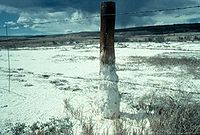
Photo from wikipedia
Soil archives are an important resource in agronomic and ecosystem sciences. If microbial communities could be reconstructed from archived soil DNA, as prehistoric plant communities are reconstructed via pollen data,… Click to show full abstract
Soil archives are an important resource in agronomic and ecosystem sciences. If microbial communities could be reconstructed from archived soil DNA, as prehistoric plant communities are reconstructed via pollen data, soil archive resources would assume even greater value for reconstructing land-use history, forensic science, and biosphere modelling. Yet, the effects of long-term soil archival on the preservation of microbial DNA is still largely unknown. To address this, we assessed the capacity of high-throughput sequencing (Illumina MiSeq) of ITS (internal transcribed spacer) and prokaryotic 16S rRNA genes for reconstructing soil microbial communities across a 20 years time-series. We studied air-dried soil archives and fresh soil samples taken from Populus bioenergy and deciduous forest research plots at the Kellogg Biological Station. Habitat and archival time explained significant amounts of variation in soil microbial α- and β-diversity both in fungal and prokaryotic communities. We found that microbial richness, diversity, and abundance generally decreased with storage time, but varied between habitat and taxonomic groups. The high relative abundance of ectomycorrhizal species including Hebeloma and Cortinarius detected in older soil archives raises questions regarding traits such as long-term persistence and viability of ectomycorrhizal propagules in soils, with relevance to forest health and ecosystem succession. Talaromyces, Paecilomyces and Epicoccum spp. were detected in fresh and across 20-year-old archived soils and were also cultured from these soils demonstrating their long-term spore viability. In summary, we found that microbial DNA in air-dried soils archived over the past 20 years degraded with time, in a manner that differed between soil types and phylogenetic groups of microbes.
Journal Title: PLoS ONE
Year Published: 2020
Link to full text (if available)
Share on Social Media: Sign Up to like & get
recommendations!